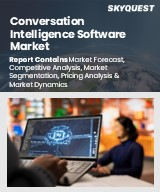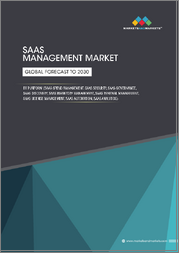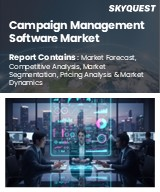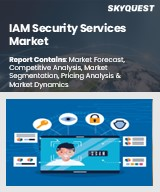
|
시장보고서
상품코드
1472994
세계의 SaaS 시장 평가 : 도입 모델별, 컴포넌트별, 사용 사례별, 사용자 유형별, 업계별, 지역별, 기회, 예측(2017-2031년)Software as a Service Market Assessment, By Deployment Model, By Component, By Use Case, By User Type, By Industry Vertical, By Region, Opportunities and Forecast, 2017-2031F |
||||||
세계의 SaaS 시장 규모는 2023년 2,081억 달러에서 2031년에 8,064억 달러에 달하며, 2024-2031년의 예측 기간에 CAGR로 18.45%의 성장이 전망됩니다. 클라우드 컴퓨팅의 세계에서 재택근무(WFH)는 전 세계에서 SaaS 시장 수요를 촉진하고 있으며, SaaS는 진입장벽이 낮고 확장성과 유연성으로 인해 수요가 급증하고 있습니다. 구독 기반 모델은 편리성, 개인화, 지속가능성을 제공한다는 점에서 인기를 끌고 있습니다. 또한 고객의 성공을 촉진하고 구매자의 유지율을 높여 지속적인 매출을 창출할 수 있다는 장점이 있습니다. 최근 몇 년간의 디지털화 추세도 세계 SaaS 시장의 성장을 가속하고 있습니다. 또한 AI와 머신러닝의 통합으로 기업은 맞춤형 SaaS 툴을 제공하여 비즈니스 기회를 한 단계 끌어올릴 수 있습니다. 이처럼 변화하는 업무 트렌드와 기술의 발전은 세계 SaaS 시장의 급속한 성장에 박차를 가하고 있습니다.
어도비(Adobe), 세일즈포스(Salesforce), 드롭박스(Dropbox) 등 주요 시장 기업의 솔루션을 사용하는 최종사용자들에게 보다 저렴한 비용으로 구독 기반 모델이 최근 인기를 끌고 있습니다. 구독형 SaaS의 가장 큰 장점은 다양한 부문에서 예측 가능하고 반복적인 수입원을 창출할 수 있는 능력을 기업에 제공할 수 있다는 점입니다. 또한 기업은 전 세계 SaaS 시장 점유율의 대부분을 차지하기 위해 타깃 고객 부문에 맞게 특별히 설계된 구독 모델을 통해 맞춤형 옵션을 제공합니다.
예를 들어 SaaS 기업용 결제 인프라 프로바이더인 패들(Paddle)은 2023년 8월, 결제 기능을 향상시키기 위해 설계된 API와 서비스 모음인 패들 빌링(Paddle Billing)을 출시했습니다. 이는 Paddle의 기본 MoR(Merchant of Record) 비즈니스를 강화하는 것이기도 합니다. 하이브리드 청구 기능을 통해 SaaS 기업은 인보이스와 신용카드를 사용하여 구독료를 청구할 수 있게 되어 일관된 고객 경험을 제공할 수 있게 되었습니다.
세계 SaaS 시장 성장에 기여하는 AI와의 통합
AI를 SaaS 시장에 도입하는 것은 예측 분석을 제공하고, 일상적인 작업을 자동화하고, 지능형 인사이트을 제공하여 비즈니스의 전반적인 효율성을 개선하고, 전통적인 관리 방식에 혁명을 일으켜 업계의 성장을 가속하는 중요한 기술 발전입니다. 빅데이터를 분석하여 더 나은 예측을 하고 의사결정 능력을 강화합니다. 머신러닝은 Salesforce가 개발한 Einstein AI에 사용되어 영업 담당자가 잠재적 리드를 식별하고 맞춤형 추천 및 고려 사항을 제공하는 데 도움을 주며, AI는 자연어 처리(NLP) 기술을 통해 SaaS에서도 활용되고 있습니다. 이해하고 해석하는 데 사용됩니다. 예를 들어 마이크로소프트의 코타나(Cortana)의 AI 기반 가상 비서는 회의 일정을 잡거나 메일을 보내고, 알림을 제공하는 등의 작업을 수행할 수 있습니다.
예를 들어 지멘스는 2024년 2월에 예측 유지보수 솔루션의 새로운 생성형 AI 기능인 Senseye Predictive Maintenance를 출시했습니다. SaaS 솔루션의 새로운 생성형 AI 기능은 생성형 AI와 머신러닝을 결합하여 두 기술의 능력을 활용하여 강력하고 완벽한 예측 유지보수 솔루션을 구축하기 위해 도입된 것으로, 예측 유지보수를 보다 쉽게 이해하고 대화할 수 있도록 하기 위해 도입되었습니다.
모바일 퍼스트 SaaS와 버티컬 SaaS 솔루션, 세계 SaaS 시장 수요 증가 전망
SaaS 시장은 모바일 기기 증가와 함께 모바일 우선 솔루션으로 빠르게 전환하고 있으며, SaaS 기업은 모바일 기기용으로 특별히 설계된 용도을 만드는 데 주력하고 있습니다. 또한 SaaS 솔루션에 대한 원활한 모바일 액세스에 대한 요구가 증가함에 따라 기업 운영에 있으며, 스마트폰 및 태블릿에 대한 의존도가 높아지면서 세계 SaaS 시장 규모에 기여하고 있습니다. 이와는 별개로, 수직적 SaaS 개발자들은 특정 산업의 요구와 워크플로우에 맞춘 소프트웨어에 집중하고 있습니다. 산업 전문 지식은 특정 산업이 직면한 어려움에 대한 이해를 높이고, 해당 산업이 직면한 문제를 해결할 수 있는 맞춤형 솔루션을 설계할 수 있게 해줍니다. 수직적 SaaS는 기업이 자신의 업무에 맞게 설계된 소프트웨어를 채택할 수 있게 함으로써 커스터마이징과 산업 전문 지식의 수준에서 해당 분야 기업의 이익을 명시적으로 드러냅니다.
세계의 SaaS 시장에 대해 조사분석했으며, 시장 규모와 예측, 시장 역학, 주요 기업의 상황과 전망 등을 제공하고 있습니다.
목차
제1장 조사 방법
제2장 프로젝트의 범위와 정의
제3장 주요 요약
제4장 고객의 소리
- 제품과 시장 정보
- 브랜드 인지 방식
- 구입 결정에서 고려된 요소
- 프라이버시와 안전 규제의 고려
제5장 세계의 SaaS 시장 전망(2017-2031년)
- 시장 규모와 예측
- 금액
- 도입 모델별
- 퍼블릭 클라우드 호스팅
- 프라이빗 클라우드 호스팅
- 하이브리드 클라우드 호스팅
- 컴포넌트별
- 소프트웨어
- 서비스
- 사용 사례별
- 고객관계관리(CRM)
- 인재 관리
- 전사적 자원 플래닝(ERP)
- BI·애널리틱스
- 컨텐츠·협업·커뮤니케이션
- 기타
- 사용자 유형별
- B2B
- B2C
- 업계별
- IT·통신
- BFSI
- 의료
- 소매·소비재
- 제조
- 교육
- 여행·접객(Hoapitality)
- 기타
- 지역별
- 북미
- 남미
- 유럽
- 아시아태평양
- 중동 및 아프리카
- 시장 점유율 : 기업별(2023년)
제6장 세계의 SaaS 시장 전망 : 지역별(2017-2031년)
- 북미
- 시장 규모와 예측
- 도입 모델별
- 컴포넌트별
- 사용 사례별
- 사용자 유형별
- 업계별
- 미국
- 캐나다
- 멕시코
- 유럽
- 독일
- 프랑스
- 이탈리아
- 영국
- 러시아
- 네덜란드
- 스페인
- 터키
- 폴란드
- 아시아태평양
- 인도
- 중국
- 일본
- 호주
- 베트남
- 한국
- 인도네시아
- 필리핀
- 남미
- 브라질
- 아르헨티나
- 중동 및 아프리카
- 사우디아라비아
- 아랍에미리트
- 남아프리카공화국
제7장 시장 매핑(2023년)
- 도입 모델별
- 컴포넌트별
- 사용 사례별
- 사용자 유형별
- 업계별
- 지역별
제8장 거시환경과 업계 구조
- 밸류체인 분석
- PESTEL 분석
- Porter's Five Forces 분석
제9장 시장 역학
- 성장 촉진요인
- 성장 억제요인(과제, 억제요인)
제10장 주요 기업의 상황
- 시장 리더 상위 5사의 경쟁 매트릭스
- 시장 리더 상위 5사의 시장 매출 분석(2023년)
- 합병과 인수/합병사업(해당하는 경우)
- SWOT 분석(시장 기업 5사)
- 특허 분석(해당하는 경우)
제11장 사례 연구
제12장 주요 기업의 전망
- Adobe Inc.
- Alphabet Inc.
- Amazon.com, Inc.
- Microsoft Corporation
- Oracle Corporation
- Salesforce, Inc.
- SAP SE
- ServiceNow, Inc.
- Shopify Inc.
- Zoom Communications, Inc.
제13장 전략적 권장
제14장 Market Xcel - Markets and Data 소개·면책사항
KSA 24.05.10Global software as a service market is projected to witness a CAGR of 18.45% during the forecast period 2024-2031, growing from USD 208.1 billion in 2023 to USD 806.4 billion in 2031F. The cloud computing world is advancing towards work-from-home (WFH) jobs, fueling the demand for the software as a service market at the global level. Software-as-a-service has low entry barriers and witnesses an upsurge in demand due to its scalability and flexibility. Subscription-based models are gaining traction since they offer convenience, personalization, and sustainability. Furthermore, businesses can attract recurring revenue by encouraging customer success and improving buyers' retention. The recent digitalization trend also promotes global software as a service market growth. Furthermore, integrating artificial intelligence and machine learning results in businesses elevating their business opportunity to the next level by providing custom SaaS tools. Henceforth, the changing work trends and tech evolution fuel rapid software as a service market expansion at the global level.
The subscription-based model has been gaining traction in recent years as renting is more affordable for end-users to avail themselves of solutions by major market players such as Adobe, Salesforce, Dropbox, and others. The major advantage of SaaS provided as a subscription model is that it offers businesses the ability to generate predictable and recurring revenue streams across various sectors. Furthermore, businesses are providing curated options in subscription models specially designed to target customer segments to capture a large portion of global software as a service market share.
For instance, in August 2023, Paddle, a payments infrastructure provider for SaaS firms, launched Paddle Billing, a collection of APIs and services designed to improve billing capabilities. It also enhances Paddle's basic Merchant of Record (MoR) business. It enables hybrid billing, allowing SaaS firms to charge subscriptions using an invoice and a credit card, providing a consistent client experience.
Integration with Artificial Intelligence Contributing to Global Software as a Service Market Growth
Implementing artificial intelligence in the software as a service market is a significant technological advancement fueling the growth in the industry as it offers predictive analytics, automates routine tasks, and provides intelligent insights improving the overall efficiency of businesses and revolutionizing the traditional way of operations. Artificial intelligence is integrated along with machine learning to analyze big data to make better predictions and enhance decision-making capabilities. Machine learning is used by Einstein AI, which Salesforce developed to help sales representatives identify potential leads and make customized recommendations and insights. Artificial intelligence is also used in SaaS through natural language processing (NLP) technology. NLP technology is used to comprehend and interpret human language, such as an AI-powered virtual assistant by Microsoft's Cortana, which can schedule meetings, send emails, and provide reminders.
For instance, in February 2024, Siemens released Senseye Predictive Maintenance, a new generative AI functionality in its prediction maintenance solution. This development was introduced to make predictive maintenance more understandable and conversational. This new generative AI feature in the Software-as-a-Service solution combines generative AI with machine learning to build a strong, complete predictive maintenance solution that utilizes both technologies' capabilities.
Mobile-First SaaS and Vertical SaaS Solutions to Boost Global Software as a Service Market Demand
The software as a service market is witnessing a rapid drift towards mobile-first solutions with the rising number of mobile devices. SaaS companies are emphasizing creating more applications specially designed for mobile devices. Reliance on smartphones and tablets for company operations is also experiencing growth with the increasing need for seamless mobile access to SaaS solutions, contributing to the global software as a service market size. Apart from this, vertical SaaS developers are focusing on software tailored to the needs and workflows of specific industries. Industry-specific knowledge provides a better understanding of a certain industry's difficulties that allows the trend to design customized solutions to cater to the pain points of that specific industry. Vertical SaaS emphasizes the benefits of the businesses in the field from the level of customization and industry expertise, as it allows businesses to employ software designed specifically for their operations.
For instance, in September 2023, Mobly, a mobile software company, unveiled its latest application for B2B enterprises which focuses on enhancing lead collection speed and accuracy. Mobly allows searching for contacts by name and company and scans a badge or business card at any event by the use of AI-powered optical character recognition (OCR). It also enhances the lead information and seamlessly synchronizes the profiles and activity data with CRM or any marketing automation platform, shortening the time for a qualified lead. A process that used to take firms days or weeks can now be completed in seconds. The Mobly app is now accessible for Apple iOS and Google Android users.
North America Holds a Significant Share of the Market
North America is the most prominent region contributing to the growth of the global software as a service market share. The main factor behind the continuous growth of the market is the rapid shift in remote and hybrid work culture accelerated after the COVID-19 outbreak. This remote culture developed the demand for SaaS products to cater to the needs of the industries to manage remote teams and keep operations running smoothly and efficiently. Another factor was the necessity of better digital collaboration tools which enabled managers and employees to engage in proper communication to improve the workflow of the operations internally and externally. Furthermore, SaaS adoption became more prevalent in industries such as BFSI, manufacturing, and retail sectors as the era of digitalization across diverse sectors.
BFSI Sector Fostering Revenue in Global Software as a Service Market Share
SaaS is utilized in the BFSI sector since it offers superior flexibility to scale up or down depending upon the demand, thereby enabling the BFSI companies to efficiently add or remove features, users, and modules as required. The scalability achievement due to the utilization of SaaS in the BFSI sector results in the organizations staying competitive and agile in rapidly changing market dynamics. Thus, due to the above-mentioned benefits the deployment of SaaS is increasing in the BFSI sector. Furthermore, the integration of AI services with SaaS is also fostering the deployment of SaaS in the banking sector.
For instance, in April 2024, Oracle Corp. unveiled Oracle Financial Services Compliance Agent which is an artificial intelligence-powered cloud solution designed to assist the banking sector in combating anti-money laundering (AML) and the remaining compliant more efficiently. The tool allows institutions to conduct low-cost hypothetical scenario testing, alter thresholds and restrictions, and detect fraudulent actions. Compliance agents may evaluate the threat profile of new financial products, proactively analyze and reduce risks associated with vulnerable typologies, and make more cost-effective, quicker, and evidence-based risk modeling choices.
Future Market Scenario (2024-2031F)
According to the global software as a service market analysis, advancement in the field of artificial intelligence will attract more demand in the software as a service market as AI capabilities offer businesses to gain better values from their data, help to automate and customize services to cater specific industry needs, enhance the security level, and supplement human capacity. Along with automation in the software as a service market, businesses may rely on the automation tool to handle the misconfiguration issue and minimize data breaches and cybersecurity risks. Vertical SaaS may gain traction as it is completely customizable, targeting customers within a specific industry.
Key Players Landscape and Outlook
The global software as a service market has a presence of multiple companies dealing in the offering of software as a service resulting in new innovations in the market at the global level. Thus, the companies are launching new software as a service offer with upgraded features. This, in turn, is resulting in intense competition in the software as a service market at the global level.
For instance, in January 2024, Temenos AG, a Switzerland-based company that deals in the offering of software as a service (SaaS) launched end-to-end Temenos Enterprise Services. The new software as a service solution (SaaS) is enabling the banking sector to utilize software solutions in just 24 hours, thereby significantly minimizing modernization costs. The major focus of Temenos AG was to increase its market presence in the global software as a service market.
In February 2023, Oracle Corporation, a provider of SaaS solutions in the United States introduced Banking Cloud Services, a new offering of composable and componentized solutions for the banking industry. Banking Cloud Services is a software as a service (SaaS) solution that will offer corporate, along with retail banks, a competitive edge to modernize their banking applications to meet the customer's needs. The service innovation associated with software as a service (SaaS) will create a lucrative opportunity for the growth of the market during the projected forecast period.
Table of Contents
1.Research Methodology
2.Project Scope & Definitions
3.Executive Summary
4.Voice of Customer
- 4.1.Product and Market Intelligence
- 4.2.Mode of Brand Awareness
- 4.3.Factors Considered in Purchase Decisions
- 4.3.1.Features and other value-added service
- 4.3.2.IT Infrastructure Compatibility
- 4.3.3.Efficiency of Solutions
- 4.3.4.After-Sales Support
- 4.4.Consideration of Privacy & Safety Regulations
5.Global Software as a Service Market Outlook, 2017-2031F
- 5.1.Market Size & Forecast
- 5.1.1.By Value
- 5.2.By Deployment Model
- 5.2.1.Public Cloud Hosting
- 5.2.2.Private Cloud Hosting
- 5.2.3.Hybrid Cloud Hosting
- 5.3.By Component
- 5.3.1.Software
- 5.3.2.Service
- 5.4.By Use Case
- 5.4.1.Customer Relationship Management (CRM)
- 5.4.2.Human Capital Management
- 5.4.3.Enterprise Resource Planning (ERP)
- 5.4.4.BI & Analytics
- 5.4.5.Content, Collaboration & Communication
- 5.4.6.Others
- 5.5.By User Type
- 5.5.1.Business to Business (B2B)
- 5.5.2.Business to Customer (B2C)
- 5.6.By Industry Vertical
- 5.6.1.IT & Telecom
- 5.6.2.Banking, Financial Services & Insurance (BFSI)
- 5.6.3.Healthcare
- 5.6.4.Retail & Consumer Goods
- 5.6.5.Manufacturing
- 5.6.6.Education
- 5.6.7.Travel & Hospitality
- 5.6.8.Others
- 5.7.By Region
- 5.7.1.North America
- 5.7.2.South America
- 5.7.3.Europe
- 5.7.4.Asia-Pacific
- 5.7.5.Middle East & Africa
- 5.8.By Company Market Share (%), 2023
6.Global Software as a Service Market Outlook, By Region, 2017-2031F
- 6.1.North America*
- 6.1.1.Market Size & Forecast
- 6.1.1.1.By Value
- 6.1.2.By Deployment Model
- 6.1.2.1.Public Cloud Hosting
- 6.1.2.2.Private Cloud Hosting
- 6.1.2.3.Hybrid Cloud Hosting
- 6.1.3.By Component
- 6.1.3.1.Software
- 6.1.3.2.Service
- 6.1.4.By Use Case
- 6.1.4.1.Customer Relationship Management (CRM)
- 6.1.4.2.Human Capital Management
- 6.1.4.3.Enterprise Resource Planning (ERP)
- 6.1.4.4.BI & Analytics
- 6.1.4.5.Content, Collaboration & Communication
- 6.1.4.6.Others
- 6.1.5.By User Type
- 6.1.5.1.Business to Business (B2B)
- 6.1.5.2.Business to Customer (B2C)
- 6.1.6.By Industry Vertical
- 6.1.6.1.IT & Telecom
- 6.1.6.2.Banking, Financial Services & Insurance (BFSI)
- 6.1.6.3.Healthcare
- 6.1.6.4.Retail & Consumer Goods
- 6.1.6.5.Manufacturing
- 6.1.6.6.Education
- 6.1.6.7.Travel & Hospitality
- 6.1.6.8.Others
- 6.1.7.United States*
- 6.1.7.1.Market Size & Forecast
- 6.1.7.1.1.By Value
- 6.1.7.2.By Deployment Model
- 6.1.7.2.1.Public Cloud Hosting
- 6.1.7.2.2.Private Cloud Hosting
- 6.1.7.2.3.Hybrid Cloud Hosting
- 6.1.7.3.By Component
- 6.1.7.3.1.Software
- 6.1.7.3.2.Service
- 6.1.7.4.By Use Case
- 6.1.7.4.1.Customer Relationship Management (CRM)
- 6.1.7.4.2.Human Capital Management
- 6.1.7.4.3.Enterprise Resource Planning (ERP)
- 6.1.7.4.4.BI & Analytics
- 6.1.7.4.5.Content, Collaboration & Communication
- 6.1.7.4.6.Others
- 6.1.7.5.By User Type
- 6.1.7.5.1.Business to Business (B2B)
- 6.1.7.5.2.Business to Customer (B2C)
- 6.1.7.6.By Industry Vertical
- 6.1.7.6.1.IT & Telecom
- 6.1.7.6.2.Banking, Financial Services & Insurance (BFSI)
- 6.1.7.6.3.Healthcare
- 6.1.7.6.4.Retail & Consumer Goods
- 6.1.7.6.5.Manufacturing
- 6.1.7.6.6.Education
- 6.1.7.6.7.Travel & Hospitality
- 6.1.7.6.8.Others
- 6.1.7.1.Market Size & Forecast
- 6.1.8.Canada
- 6.1.9.Mexico
- 6.1.1.Market Size & Forecast
All segments will be provided for all regions and countries covered
- 6.2.Europe
- 6.2.1.Germany
- 6.2.2.France
- 6.2.3.Italy
- 6.2.4.United Kingdom
- 6.2.5.Russia
- 6.2.6.Netherlands
- 6.2.7.Spain
- 6.2.8.Turkey
- 6.2.9.Poland
- 6.3.Asia-Pacific
- 6.3.1.India
- 6.3.2.China
- 6.3.3.Japan
- 6.3.4.Australia
- 6.3.5.Vietnam
- 6.3.6.South Korea
- 6.3.7.Indonesia
- 6.3.8.Philippines
- 6.4.South America
- 6.4.1.Brazil
- 6.4.2.Argentina
- 6.5.Middle East & Africa
- 6.5.1.Saudi Arabia
- 6.5.2.UAE
- 6.5.3.South Africa
7.Market Mapping, 2023
- 7.1.By Deployment Model
- 7.2.By Component
- 7.3.By Use Case
- 7.4.By User Type
- 7.5.By Industry Vertical
- 7.6.By Region
8.Macro Environment and Industry Structure
- 8.1.Value Chain Analysis
- 8.2.PESTEL Analysis
- 8.2.1.Political Factors
- 8.2.2.Economic System
- 8.2.3.Social Implications
- 8.2.4.Technological Advancements
- 8.2.5.Environmental Impacts
- 8.2.6.Legal Compliances and Regulatory Policies (Statutory Bodies Included)
- 8.3.Porter's Five Forces Analysis
- 8.3.1.Supplier Power
- 8.3.2.Buyer Power
- 8.3.3.Substitution Threat
- 8.3.4.Threat from New Entrant
- 8.3.5.Competitive Rivalry
9.Market Dynamics
- 9.1.Growth Drivers
- 9.2.Growth Inhibitors (Challenges and Restraints)
10.Key Players Landscape
- 10.1.Competition Matrix of Top Five Market Leaders
- 10.2.Market Revenue Analysis of Top Five Market Leaders (in %, 2023)
- 10.3.Mergers and Acquisitions/Joint Ventures (If Applicable)
- 10.4.SWOT Analysis (For Five Market Players)
- 10.5.Patent Analysis (If Applicable)
11.Case Studies
12.Key Players Outlook
- 12.1.Adobe Inc.
- 12.1.1.Company Details
- 12.1.2.Key Management Personnel
- 12.1.3.Products & Services
- 12.1.4.Financials (As reported)
- 12.1.5.Key Market Focus & Geographical Presence
- 12.1.6.Recent Developments
- 12.2.Alphabet Inc.
- 12.3.Amazon.com, Inc.
- 12.4.Microsoft Corporation
- 12.5.Oracle Corporation
- 12.6.Salesforce, Inc.
- 12.7.SAP SE
- 12.8.ServiceNow, Inc.
- 12.9.Shopify Inc.
- 12.10.Zoom Communications, Inc.
Companies mentioned above DO NOT hold any order as per market share and can be changed as per information available during research work



















